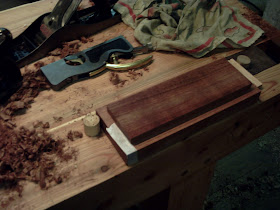So last night didn't offer any possibilities for woodworking.
But today I have ordered spare parts, and therefore even Gustav acknowledges the fact that we have to wait until they arrive before we can repair the bike. This has given me a chance to get on with the woodworking which I enjoy quite a bit more.
A couple of days ago, I sawed my first board on the mulesaw. I would love to be able to say that it was a success, but it wasn't.
The foundation is not sturdy enough, and the 6x6" stiffeners that I have attached didn't help enough. So I have decided to move on to plan C (Plan B was the stiffeners). Plan C is to fill up the inside of the brick foundation with concrete.
So on the large scale woodworking side, I have been making the foundation ready for this concrete adventure. It will roughly require 0.8 cubic metre to fill it up. Hopefully I can get it done tomorrow.
On the small scale woodworking side, I started a display case for a model steam engine I finished on the previous contract on the ship.
The idea is to make a nice hardwood base, and then I'll see how I manage to make the strips for the glass.
It should help to get the steam engine out of its current domicile (a red plastic cookie box) and take up some space inside the house instead of in the workshop.
The foundation of the crank and pulleys of the mulesaw
Planing the foundation for the steam engine
The rabbets have been made, and a small chip has been reglued
The model steam engine




I'll be honest, I'm not too sure what a mulesaw is. I've heard the term "muley" referring to a saw and that's it. I was under the assumption that it was similar to the old fashioned cranksaws that could be man powered or horsepowered. That is just a wild guess though.
ReplyDeleteI like the steam engine. I can remember making one in school similar to yours.
I have once read that it is the American term for a horizontal single blade reciprocating sawmill. But it can be that I have remembered it wrong. Muley sound right, and it is powered by a crank.
ReplyDeleteOn another place I read that they were never wildly popular in America since they are rather slow. The author reasoned that wood was more scarce in Europe, and labour was plentiful and cheap. So it made sense to use a saw that didn't leave as wide a kerf as a circular saw.
It is also able to saw wider boards than the typical circular saw.
In Germany (where they have a lot more woods than in Denmark) they still use them, but a slightly different model. They can have many blades e.g. 10 next to each other. they move vertically, and you send in one log, and it will immediately be processed into boards of the thickness you have between your blades.
Here is a link to a saw similar to mine.
http://www.youtube.com/watch?v=Gs3TSHlXn2Y
The German term is Gattersäge, if you want to google those.
Nice shoulder plane. :o)
ReplyDeleteI knew you would like it :-)
ReplyDeleteAnd I am happy that I found a real project where I could use it.
I bought a Lie Nielsen No1. I have yet to test it in the workshop and write a review. But it sure is a cute little plane.
The idea was that it would fit Asgers small hands, but actually it is even difficult for him to get his fingers around the rear tote.
Maybe a coffin shaped woodie would be an ergonomic (and economical) alternative.
DeleteIt could be. Anyway, I have thought about buying one for a long time. apparently someone uses them instead of block planes.
DeleteForget the case... you oughta hook up the little steam engine to a reciprocating saw or something and get some use out of it! (Kidding, of course).
ReplyDeleteActually I have seen some youtube videos of someone who had made setups like that. It is truly amazing. I sometime fantasise about making some model display, but there are so many other things that I choose to do first.
ReplyDelete